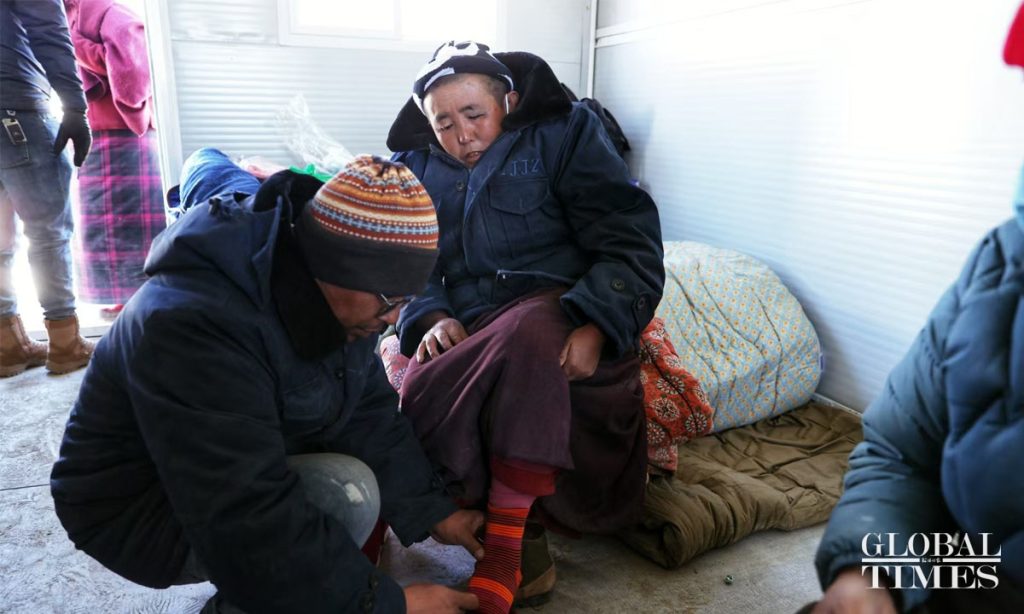Aftershocks hit Xizang; resident resettlement efforts unaffected: local officials

Dingri County in Southwest China's Xizang Autonomous Region continued to feel tremors after a 6.8-magnitude quake on January 7, with the strongest aftershock at a magnitude of 5.0 jolting the area on Monday night. No casualties have been reported so far. Major transport lines and power networks in epicenter areas perform normally.
According to the China Earthquake Networks Center (CENC), a magnitude 4.9 quake occurred at 8:57 pm on Monday, followed by a magnitude 5.0 aftershock a minute later. Both were shallow quakes with a depth of 10 kilometers. Another 3.2-magnitude quake jolted Dingjie, Dingri's east neighboring county, at 4:14 am on Tuesday at a depth of 10 kilometers, said a report issued by the CENC.
According to CENC, the 5.0-magnitude shock in Dingri has been the strongest one among all the aftershocks monitored since January 7.
The tremors have caused the collapse of some already dilapidated houses, but no casualties have been reported so far since local residents have moved into tents and prefabricated houses, said Tashi Dondrup, the county head of Dingri, as reported by the Xinhua News Agency.
According to Tashi Dondrup, local authorities contacted the villages at the epicenters immediately after the two tremors and are assessing the specific situation.
Local transportation and emergency authorities have examined the important traffic channels within the aftershock areas. As of 23:30 pm on Monday, the national highways 318 and 219, as well as the provincial roads 515 and 303 remain unobstructed. The power system in the epicenters also operated normally.
An army aviation brigade under the Chinese PLA Xizang Military Command sent out two helicopters on Tuesday morning to carry out aerial surveys over the townships of Golok, Tsogo and Chamco to examine the destruction of houses and roads, Xinhua reported.
As Dingri experienced constant aftershocks, the Global Times learned from two local village officials in Dingri on Tuesday afternoon that the current tremors have had little impact on the villagers' access to water and electricity, as well as on the life-supply channels.
Gadan Village official Wu Qixun said that despite the tremors being frequent, the situation is stable with no casualties in the village. "The National Grid staff have been stationed here to make sure the power system works normally. Residents can have access to water. And the roads for transporting life supplies are clear and open. Currently, we are not too worried about the afterquakes as we have enough machinery, working staff and rescue teams," Wu told the Global Times.
Zacun Village official Tenzin Phuntsok told the Global Times that all collapsed houses were examined after the Monday night aftershocks and all villagers were safe. Transportation, local access to water and electricity have not been affected. He said the village has finished building 80 prefabricated houses with 70 more under construction. "Tomorrow morning, after all the houses have been set up and equipped with electricity, our villagers will all be able to move in. Then I'll feel much relieved," said Tenzin Phuntsok.
Given the risks of continued aftershocks, local authorities will conduct further checks on highway infrastructure and the electricity grid in earthquake-affected areas on Tuesday, according to CCTV.
Currently, a total of 407 people have been rescued, and over 47,500 disaster-affected individuals have been properly relocated. The earthquake relief efforts are being carried out effectively and in an orderly manner, CCTV reported on Monday.
According to the Ministry of Emergency Management, as of 12 pm on Monday, the rescue forces have checked more than 6,700 damaged houses and built 1,825 sets of prefabricated houses. Over 199,000 pieces of emergency supplies and more than 260 tons of living materials have been orderly distributed to the affected people.